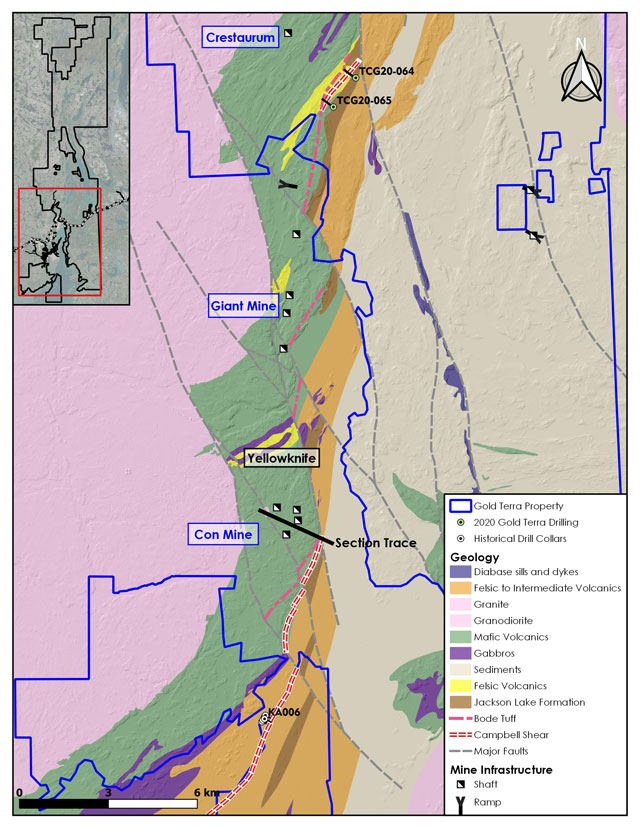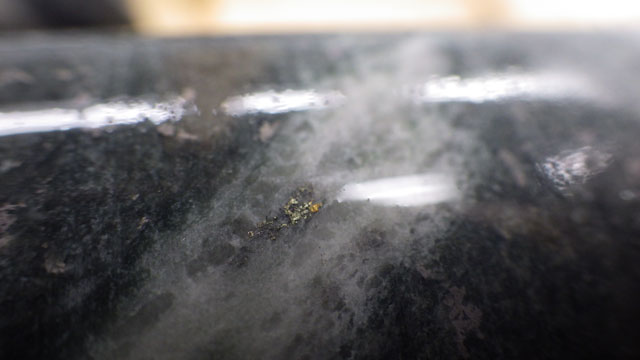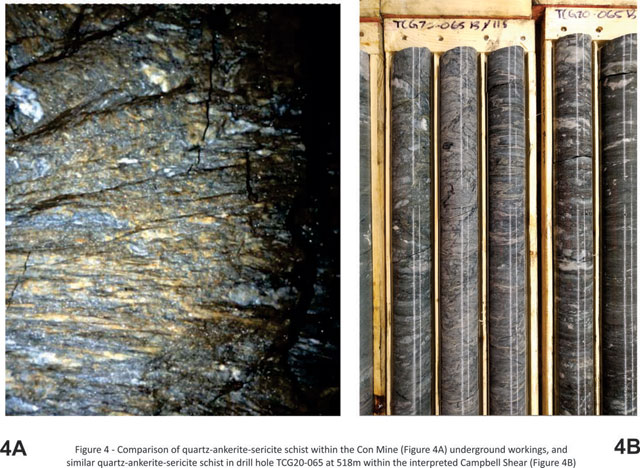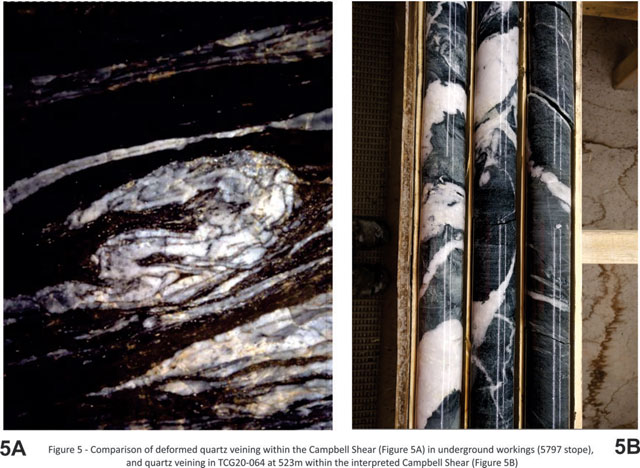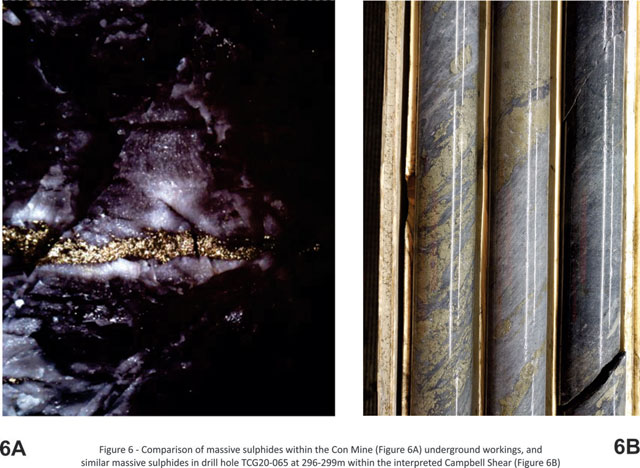June 2, 2020, Vancouver, B.C. – Gold Terra Resource Corp. (TSX-V: YGT; Frankfurt: TX0; OTC Pink: TRXXF) ("Gold Terra" or the "Company") provides an update on its ongoing compilation of all available data on the high-grade Campbell Shear zone as the Company prepares for the next drilling campaign on its Yellowknife City Gold property ("YCGP") located adjacent to the past producing Con and Giant mines in the Northwest Territories. The Campbell and Giant Shear zones are prolific regional structures in the Yellowknife mining camp, responsible for the majority of the 14 million ounces ("Moz") of gold mined at the Con and Giant mines up to their closure in the early 2000s.
The Company's next drilling program will focus on high-grade gold, testing a number of targets on the Campbell Shear from the compilation work currently underway and on further expanding the Crestaurum high-grade deposit along strike and at depth. The Company will provide further details on the drilling campaign in the near future.
President and CEO David Suda stated: "The second half of 2020 will be the most exciting time for Gold Terra as the Campbell Shear system emerges as the primary focus for the next drilling campaign for a potential new discovery for Gold Terra. We are identifying a number of high-grade drill targets on the Campbell Shear and are also planning the next drilling campaign at the high-grade Crestaurum gold deposit to expand the current resource (November 2019)."
The Campbell Shear zone is within secondary and tertiary structures associated with a large district-scale structure, the Yellowknife River Fault Zone ("YRFZ"), that straddles the Company's YCGP over 67 km of strike length on the southern and northern extensions. In reference, the YRFZ is equivalent to the better known prolific gold camps in Abitibi, like the Destor-Porcupine and the Larder Lake-Cadillac Fault zones. The Campbell Shear zone and associated structures such as the Con Shear are exceptional due to the high-grade nature of the lode deposits (approximately 16 g/t Au).
Gold production in Yellowknife over a period of 60 years was along 8 kilometres of the YRFZ trend, or approximately 10% of the known fault structure, which includes the high-grade gold mineralization on the Campbell Shear. It remains largely unexplored north and south of the historical mines, on ground now controlled by Gold Terra. Of particular importance, from a series of holes from the 1960s drilled on the Company's Southbelt property, 2 kilometres south from the southern end of the Con mine workings, one hole (KA-06) intersected mineralization in the Campbell Shear at a shallow depth with 8.23 g/t over 7.8 metres1(Figure 1).
On the Northbelt, the Company's first two holes completed this winter successfully intersected the favorable stratigraphic sequence associated with the Campbell Shear zone at the Con mine (Figure 1). Both holes, drilled 1 kilometre apart, intersected multiple shear zones containing quartz veining and sulphides with one of the holes having visible gold (Figure 2). Although gold values were anomalous (< 0.22 g/t), the alteration and shearing indicate similarities to the Campbell Shear structure and potential proximity to high-grade gold mineralization.
Technical Summary:
The Campbell Shear
At the Con mine, the Con and Campbell Shear zones are separated by approximately 2 kilometres of stratigraphy, with the Campbell Shear crossing different geological units and varying from occurring adjacent to and up to 1 kilometre west of the Jackson Lake Formation (Timiskaming equivalent) and east of a breccia unit called the Bode Debris Flow. Within these bracketing units are extensive areas of deformation up to and including sericite-carbonate shears that were the host to the Campbell Shear ores.
Analysis of the Campbell Shear at the Con mine showed that although the shear has extensive strike (+10 kilometres), width (up to 175 metres) and depth (mine workings to approximately 2,000 metres), only a very small percentage of the shear (approximately 1%) was mined as high-grade lode gold deposits (Figure 3).
Gold Terra's technical team is currently completing a compilation of all available historical drill data from the Con mine and recent Gold Terra surface sampling, airborne geophysics, LiDAR and soil and lake geochemistry to develop specific drill targets along the Campbell Shear zone. In parallel, an ongoing structural analysis is being carried out from the Campbell Shear mine area to better understand the controls on the high-grade gold lodes, which will assist in the Company's targeting of the Campbell Shear both to the north and south of the Con mine.
Campbell Shear Target on Northbelt
Work to date on YCGP indicated that the stratigraphy hosting the Campbell Shear of the Con mine (responsible for approximately 5 of the 6 Moz produced) possibly extends onto the Northbelt ground held by Gold Terra.
During the winter of 2020, the Company drilled two holes at a 1 kilometre spacing for a total of 1,274 metres targeting the Campbell Shear stratigraphy. Both holes successfully intersected the Campbell stratigraphy package including the Jackson Lake Formation in the hanging wall and the Bode Debris Flow in the footwall. The two holes intersected broad zones (up to 200 metres) of Campbell Shear deformation style and shearing, including chlorite-carbonate-sericite alteration in multiple shears that were accompanied by quartz-carbonate veining. Visible gold was noted in one hole (Figure 2) but gold values did not exceed 0.22 g/t. The vein systems also had significant multi-percent sulphide mineralization which included anomalous arsenic and antimony. Haloes around these mineralized zones for up to tens of metres were elevated in potassium and depleted in sodium. All of the features intersected in the two holes are recognizable characteristics from the Con mine with the appearance of the Campbell shear proximal to the historically mined ore zones.
Photos below show that the shearing, alteration and mineralization intersected in Gold Terra's holes are very similar to the Con mine ore (Figure 4, Figure 5, Figure 6).
Campbell Shear Target on Southbelt
On Gold Terra's Southbelt property, the extension of the Con and Campbell Shears covers approximately 8 kilometres of strike south of the Con mine. The extension of the Campbell Shear has been established by the mapping of the recognizable Campbell Shear stratigraphic package and historical drilling.
Historical exploration programs along the Campbell Shear on Gold Terra's Southbelt property included a small exploration drilling program of approximately 6 holes (KA series) over a 250-metre strike length. All holes intersected multigram gold values, with the best hole (KA-06) reportedly intersecting 8.23 g/t over 7.8 metres1 at a depth of approximately 110 metres below surface. Additionally, surface sampling by Gold Terra of exposed sheared zones to the west of the Campbell Shear (hanging wall) included quartz veins with up to 94.9 g/t Au (NR September 23, 2015).
Other limited historical drilling carried out on Gold Terra's Southbelt property did not test the Campbell Shear target. Gold Terra has 8 kilometres of a known high-grade gold bearing structure that is relatively unexplored with high potential to host Campbell shear-style mineralization.
Note:
1The intersection stated here is historical in nature and has not been verified by Gold Terra. Hole location, downhole survey, assay and lithologic data was obtained from the Con mine databases, and therefore is assumed by Gold Terra to be reasonably valid.
The technical information contained in this news release has been reviewed and approved by Joseph Campbell, Chief Operating Officer, a Qualified Person as defined in National Instrument 43-101 – Standards of Disclosure for Mineral Projects.
About the Yellowknife City Gold Project
The YCG project encompasses 783 sq. km of contiguous land immediately north, south and east of the City of Yellowknife in the Northwest Territories. Through a series of acquisitions, Gold Terra controls one of the six major high-grade gold camps in Canada. Being within 10 kilometres of the City of Yellowknife, the YCG is close to vital infrastructure, including all-season roads, air transportation, service providers, hydro-electric power and skilled tradespeople.
The YCG lies on the prolific Yellowknife greenstone belt, covering nearly 70 kilometres of strike length along the main mineralized shear system that host the former-producing high-grade Con and Giant gold mines. The Company's exploration programs have successfully identified significant zones of gold mineralization and multiple targets that remain to be tested which reinforces the Company's objective of re-establishing Yellowknife as one of the premier gold mining districts in Canada.
Visit our website at www.goldterracorp.com.
For more information, please contact:
David Suda, President and CEO
Phone: 604-928-3101 | Toll-Free: 1-855-737-2684
dsuda@Goldterracorp.com
Neither the TSX Venture Exchange nor its Regulation Services Provider (as that term is defined in the policies of the TSX Venture Exchange) accepts responsibility for the adequacy or accuracy of this release.
Cautionary Note Regarding Forward-Looking Information
Certain statements made and information contained in this news release constitute "forward-looking information" within the meaning of applicable securities legislation ("forward-looking information"). Generally, this forward-looking information can, but not always, be identified by use of forward-looking terminology such as "plans", "expects" or "does not expect", "is expected", "budget", "scheduled", "estimates", "forecasts", "intends", "anticipates" or "does not anticipate", or "believes", or variations of such words and phrases or statements that certain actions, events, conditions or results "will", "may", "could", "would", "might" or "will be taken", "occur" or "be achieved" or the negative connotations thereof.
All statements other than statements of historical fact may be forward-looking information. Forward-looking information is necessarily based on estimates and assumptions that are inherently subject to known and unknown risks, uncertainties and other factors that may cause the actual results, level of activity, performance or achievements of the Company to be materially different from those expressed or implied by such forward-looking information. In particular, this news release contains forward-looking information regarding the Campbell Shear system emerging as the primary focus for the next drilling campaign for a potential new discovery for Gold Terra, the expansion of the current resource at Crestaurum, the indications of potential proximity to high-grade gold mineralization from the two holes drilled in the Campbell Shear stratigraphy, the stratigraphy hosting the Campbell Shear of the Con mine possibly extending onto the Northbelt ground held by Gold Terra, the high potential to host Campbell shear-style mineralization on 8 kilometres of strike length on the Southbelt, and the Company's objective of re-establishing Yellowknife as one of the premier gold mining districts in Canada.
There can be no assurance that such statements will prove to be accurate, as the Company's actual results and future events could differ materially from those anticipated in this forward-looking information as a result of the factors discussed in the "Risk Factors" section in the Company's most recent MD&A and annual information form available under the Company's profile at www.sedar.com.
Although the Company has attempted to identify important factors that would cause actual results to differ materially from those contained in forward-looking information, there may be other factors that cause results not to be as anticipated, estimated or intended. The forward-looking information contained in this news release is based on information available to the Company as of the date of this news release. There can be no assurance that such statements will prove to be accurate, as actual results and future events could differ materially from those anticipated in such statements. All of the forward-looking information contained in this news release is qualified by these cautionary statements. Readers are cautioned not to place undue reliance on forward-looking information due to the inherent uncertainty thereof. Except as required under applicable securities legislation and regulations applicable to the Company, the Company does not intend, and does not assume any obligation, to update this forward-looking information.
Figure 1: Part of the YCGP showing (1) the trace of the Campbell Shear zone, (2) the location of the winter 2020 two holes that targeted the Campbell Shear stratigraphy on the Northbelt, and (3) location of KA-6 on the Southbelt property.
Figure 2: Visible gold intersected in hole TCG20-064 at 536.5m (targeting the Campbell Shear stratigraphy).
Figure 3: Cross-section of the Con mine's Campbell Shear (Source: Miramar Mining, 2001)
Figures 4-6: Comparison of alteration, quartz veining and sulphide mineralization from the Con mine (A) left side and Gold Terra drill holes within the Campbell Shear stratigraphy (B) right side.

